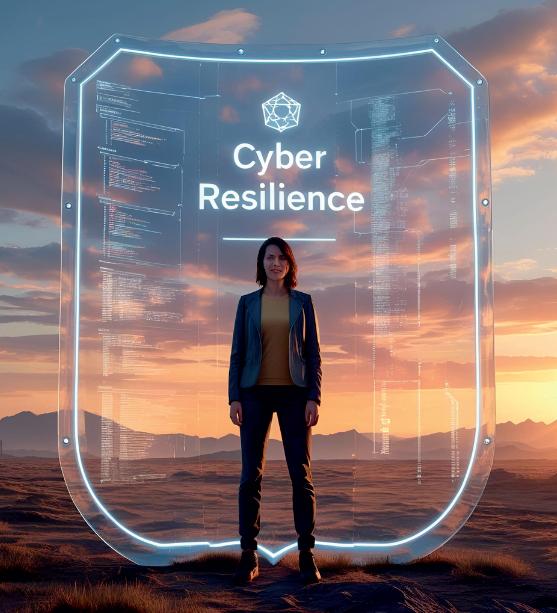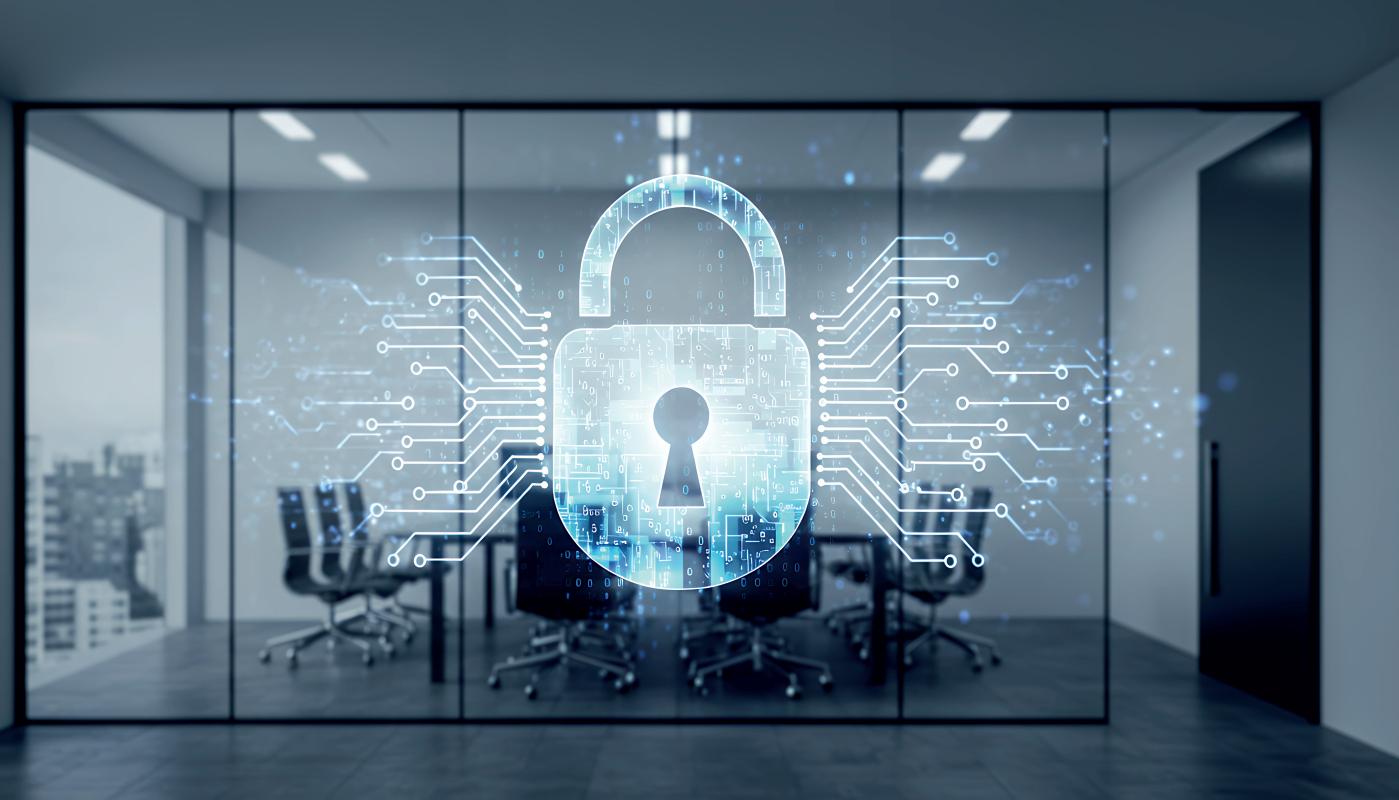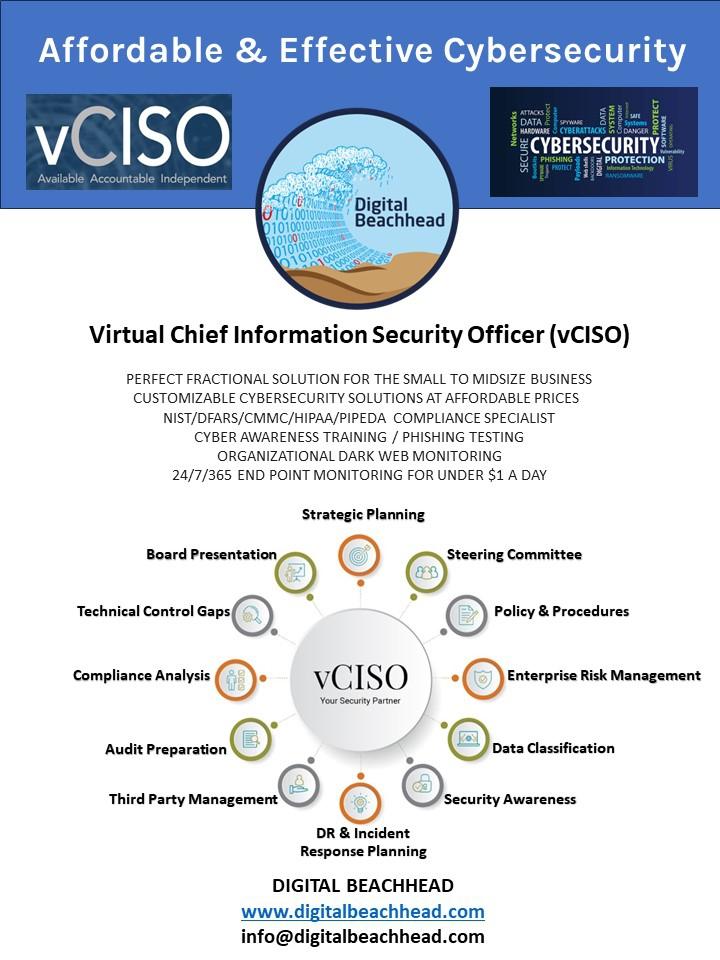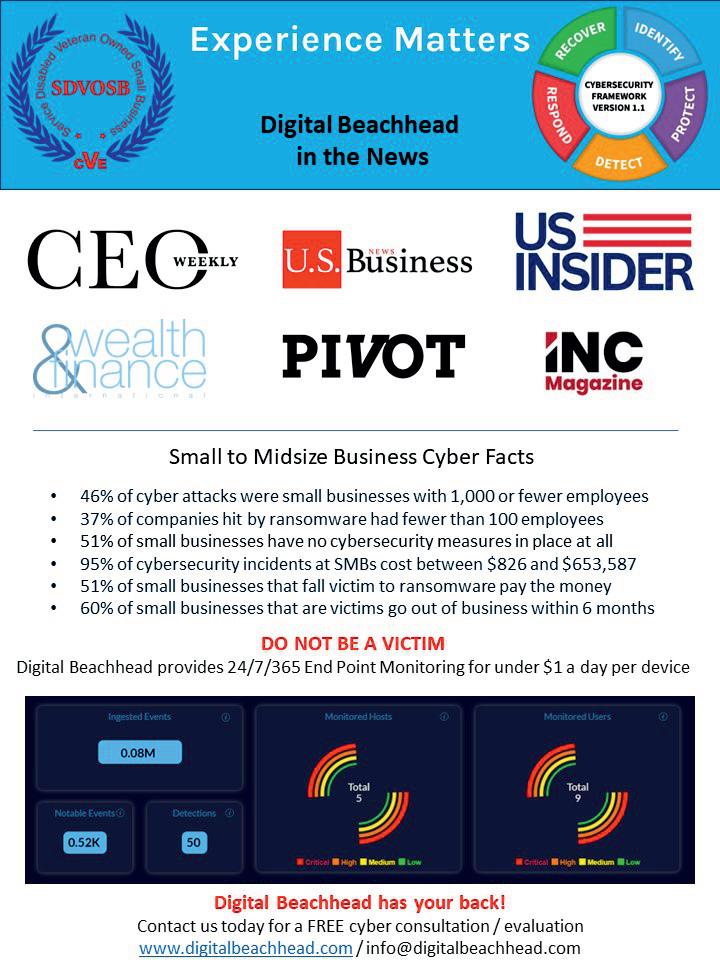






Editor’s N o t e









Editor’s N o t e

Welcome to the inaugural edition of Digital Beachhead Quarterly, by Insights Success where innovation meets impact, and technology becomes a force multiplier for bold ideas and resilient strategies.
AswelaunchVolume1,westandattheedgeofarapidlyevolvingdigitalfrontier The“beachhead”inourname isn’tjustametaphoritreflectsourbeliefthattransformationstartswithastronglanding,adecisivepointofentry intotheunknown.Thismagazineisourcollectiveplatformtoexplorethosedefiningmomentswheredisruption, determination,anddigitalingenuitycollide.
In this issue, we spotlight thought leaders who are redefining sectors through cloud strategy, cybersecurity architecture, digital diplomacy,AI governance, and beyond. From government tech modernization to private sectoragility,everystoryrepresentsamission-criticalshiftstrategic,scalable,andsustainable.
Ouraimissimple:toserveasabridgebetweenvisionandexecution.Whetheryou'reaseasoneddigitaloperator, a policy architect, a startup founder, or a curious reader standing on the shores of transformation, Digital Beachhead offers perspectives designed to challenge assumptions, ignite conversation, and chart forward motion.
Thisquarterlywillbeshapedbyvoicesacrosstheglobalecosystempublic,private,academic,anddefense.We believeinnovationflourisheswhensilosaredismantled,andknowledgeisdeployedwithclarityandcourage.
Thankyouforjoiningusonthisjourney Yourattention,insight,andfeedbackwillbeourgreatestfuelaswe continuetobuild,disrupt,andinspire.Holdfast.Thetideisdigital—andthisisonlythebeginning.
HappyReading!



CEO Corner
Cyber Resilience and Why it Matters
Network Resilience: The Digital Lifeline of Modern Business

Howard Zach
How to Trust Zero-Trust
I Got Into Your Office. Let’s Talk About That.
From AI to Quantum Computing
Top Emerging Digital Trends Shaping the Future
CEO Corner – Mike Crandall A
Jeff Tomkiewicz



Peter Sopczak

Network Resiliency Starts With Simplicity: Smarter Cybersecurity for SMBs Static Solutions Security Consulting Ltd.
Rachel’s Relevant Ramblings -Scammy, Sloppy, and Surprisingly Successful = Smishing

Ralf Schwoerer
Rachel Herren

Cloud Apps Management: Is Your Business in Control? Ralf Schwoerer – Silverback Consulting
S
From Startup to Excellence
Essential Digital Business Strategies for Entrepreneurs







In a world where digital infrastructure underpins nearly
everyaspectofourlives,fromcriticalnationalservices to our daily banking and communication, it’s no longer enoughtofocussolelyoncybersecurity.Asthreatsgrowmore sophisticated and persistent, the conversation has shifted from preventing breaches to surviving them. Enter cyber resilience,aconceptthatisfastbecomingthecornerstoneof moderndigitalstrategy
Cyber resilience refers to an organization’s ability to continuously deliver the intended outcome despite adverse cyberevents.Itencompassesnotonlythecapabilitytodefend againstattacksbutalsotorespond,recover,andadaptintheir aftermath.
Think of it this way: cybersecurity is the armored door that triestokeepintrudersout.Cyberresilience,ontheotherhand, istheentirefortifiedhouse—designednotonlytodeterbreakinsbutalsotolimitdamage,ensurerecovery,andlearnfrom eachattemptedintrusion.
Attacks Are Inevitable Despite the best defenses, cyber incidents are increasingly unavoidable. Phishing attacks, ransomware, data breaches, and zero-day exploits bypass even well-maintained systems. Resilience ensures that when—notif—abreachoccurs,thefalloutismanageable.
AsinglehourofITdowntimecancostenterprisesthousands, if not millions, of dollars. Beyond financial loss, service interruptions damage reputation, customer trust, and even regulatorystanding.Resiliencestrategies,includingfailover systemsanddatabackups,cansignificantlyreducerecovery
times.
Governments and industries are introducing stricter cybersecurity regulations Frameworks like the NIST Cybersecurity Framework, GDPR, and CISA guidelines emphasize not just prevention but resilience. Being cyber resilientisnowamatteroflegalcomplianceinmanysectors.
How an organization handles a cyber incident often matters morethantheincidentitself.Afast,transparent,andeffective responsecanpreservetrustandmarketposition.Failuretoact quickly—oratall—canleadtolong-termdamage.
Building cyber resilience is not a one-time project; it’s a dynamic process that involves people, technology, and culture.Herearethekeycomponents:
Risk Assessment: Understand what assets are most critical andwhichthreatsaremostlikelytoaffectthem.
Incident Response Planning: Develop and regularly test responseplanssothatteamsknowexactlyhowtoactduringa crisis.
Continuous Monitoring: Employ tools and practices that providereal-timevisibilityintosystemsanddetectanomalies quickly
Backup and Recovery: Regularly backup data and ensure systemscanberestoredefficiently.


Training and Awareness: Educate employees on best practicesandmakesecurityasharedresponsibilityacrossall departments.
Supply Chain Security: Ensure vendors and partners meet securitystandards,asthird-partyrisksareagrowingconcern.
True resilience starts at the top. Leadership must prioritize cyber resilience as part of the overall business strategy Investment in the right tools and talent, ongoing education, andregulartestingofsystemsandprotocolsareessential.
Moreover, fostering a culture where employees feel empoweredandresponsibleforcyberhygienecantransform resilience from a technical challenge into an organizational strength.
Cyber resilience isn’t just a buzzword it’s a business imperative. In a landscape where threats evolve daily, being resilient means being prepared, adaptable, and always one step ahead. For businesses, governments, and individuals alike,thegoalisnolongertobuildwallstallenoughtoprevent every breach, but to become strong and flexible enough to withstand,recover,andgrowfromwhatevercomesnext.
As the saying goes: "Resilience is not about avoiding the storm,it'saboutlearningtodanceintherain."
Wanttobuildamorecyber-resilientorganization?Contactus at Digital Beachhead, to start www.digitalbeachhead.com with a risk audit, train your employees, and explore frameworks like NIST or ISO 27001 to help guide your journey




Intoday’shyper-connectedworld,whereeverythingfrom
financial transactions to patient care depends on continuous digital access, network resilience has becomeoneofthemostcritical,yetoverlooked,prioritiesin ITstrategy.Networkresiliencereferstoasystem'sabilityto anticipate, withstand, recover from, and adapt to adverse conditions, stresses, attacks, or failures. Unlike traditional uptime strategies, which focus narrowly on availability, resilience emphasizes the ability to maintain critical operations under stress, even when parts of the network are compromised.
Fromcyberattacksandpoweroutagestosimplehumanerrors and software bugs, today’s networks are under constant threat.Thequestionisn’twhetheryoursystemswillbetested, it’s when, and how prepared you are As organizations increasingly rely on remote work and cloud infrastructure, ensuringthatyournetworkcanbouncebackisvital.
At its core, network resilience is about business continuity. When a cloud region goes dark, a DNS service fails, or a cyberattack locks down systems, resilient networks ensure that critical services remain available, sometimes without usersevennoticingaglitch.
What does resilience look like in practice? It’s not a single solution;it’sastrategybuiltonmultiplepillars:
Ÿ Redundancy:MultipleISPs,andcloudregions,toavoid singlepointsoffailure.
Ÿ Backup: regularly create and test backups of critical systemstoensurerapidrecovery
Ÿ Segmentation: Containing attacks so they don’t ripple acrosssystemsandspread.
Ÿ Monitoring & Telemetry: Real-time observability to catchanomaliesbeforetheyescalate.
Ÿ ZeroTrustArchitecture:Authenticatingusersanddevices constantly,notjustonce.
Ÿ FailoverPlanning:Pre-testeddisasterrecoveryplaybooks andautomationforinstantresponse.
Asthedigitalworldgrowsmorecomplex,networkresilience isn’tjustatechnicalconcern.It’sabusinessimperative,atrust issue,andacompetitiveadvantage.
Evenshortoutagescanhavedramaticimpacts.Insectorslike healthcare,finance,andlogistics,afewminutesofdowntime can translate into lost trust, regulatory penalties, or worse, humanharm.
As technologies like AI-driven network automation, edge computing,and6Gbegintoreshapeinfrastructure,thefuture ofresiliencewillbecomeevenmoredynamic.Networkswill soon be capable of self-healing, rerouting, and defending in realtime,withouthumanintervention.
Thefirststeptowardresilienceisaskingtherightquestion:“If our network failed right now, what would happen?” If you don’tliketheanswer,it’stimetorethinkyourapproach.
While network resilience ensures the internal gears of your digitaloperationsstayturning,there'sanotherequallycritical layer: your public-facing presence. Because for most users and customers, the first point of failure they’ll notice isn’t yournetwork,it’syourwebsite.
From e-commerce giants to local service providers, the website has become the face of business. It drives sales, collectsdata,supportscustomerservice,andinmanycases,is the product. But as websites become more dynamic and integrated with third-party tools, APIs, and cloud services, theyalsobecomemorefragile.Oneweaklinkcanbreakthe entirechain.

Websiteresiliencyistheabilityofyourwebinfrastructureto withstand attacks, absorb disruptions, recover quickly, and maintain continuous service during unexpected events, without losing performance or trust. These events might include:
Ÿ Sudden spikes in traffic (e.g., product launches, viral events)
Ÿ CyberattackslikeDDoS(DistributedDenialofService)
Ÿ Cloudproviderorhostingoutages
Ÿ Softwarebugsormisconfigurations
Ÿ Third-partyAPIfailures
Ÿ DowntimeIsExpensive.
Websitedowntimeismorethananinconvenience;it’sadirect financialhit.ForlargeenterpriseslikeAmazon,evenasingle minute offline can cost over $1 million in lost revenue. For smallerbusinesses,evenashortoutageduringpeaktrafficcan leadtolastinglossesandcustomerchurn.Intoday’salwaysondigitallandscape,everysecondofdowntimecounts.
Ÿ UserExpectationsAreHigherThanEver
Usersexpectlightning-fast,always-onexperiences.Ifasiteis slow or unavailable, 79% of users say they’re less likely to return.
Ÿ CyberThreatsAreEvolving
Modern attacks don’t just steal data; they try to bring down your site DDoS attacks, credential stuffing, and plugin exploits can cripple websites. If your domain is attacked, compromised, or used in spam campaigns, it can be blacklistedbyemailprovidersandsecurityservices.Thiscan severely impact your ability to send emails, even to trusted contacts. Marketing campaigns may bounce, internal communication can be disrupted, and customer trust erodes quickly Protecting your domain’s integrity is critical to maintaining not just website availability, but also email deliverability
Ÿ YourWebsiteIsPartofYourBrand
A slow, broken, or offline website reflects poorly on your business,eveniftheproblemisoutsideyourcontrol.
Building resilience means safeguarding every layer of your digital ecosystem. Network resiliency ensures your internal operations stay uninterrupted, while website resiliency protectsthevitalgatewaythroughwhichyourbrandconnects with customers.Together, they create a seamless experience thatkeepsyourbusinessrunningsmoothly,eveninthefaceof unexpectedchallenges.Prioritizingbothisessential,notjust to prevent downtime, but to maintain customer confidence anddrivelong-termsuccess.
HelenH.Thomas


Introduction
In a world of escalating cyber threats, sprawling digital
ecosystems, and sensitive data flowing across borders, the traditional “trust but verify” approach no longer suffices. The Zero Trust security model, founded on the principle of 'never trust, always verify,' has emerged as a critical framework particularly for pharmaceutical distribution networks, cross-border logistics firms, and Small-Medium Business (SMB) manufacturers navigating moderncybersecurityrisks
At Digital Beachhead (DBH), we anchor our cybersecurity offerings in ZeroTrust principles to protect sensitive supply chains,ensureregulatorycompliance,andmaintainbusiness continuity.ButwhatexactlyisZeroTrust—andhowdoyou trustittosafeguardyourbusiness?
1.WhatIsZeroTrust?
Zero Trust is not a product—it’s a security philosophy and architecturalmodelthatassumesnouser,device,ornetwork isinherentlytrustworthy,evenifitresidesinsidethecorporate perimeter.Incontrasttolegacydefensesthatrelyheavilyon perimeter protection, Zero Trust continuously enforces granular access controls, identity verification, and segmentation.
For DBH clients in pharma distribution and SMB manufacturing, this philosophy is indispensable. Supply chainsareglobal,partnersarenumerous,andendpointsspan factories, warehouses, and cross-border transit hubs. In this complexlandscape,ZeroTrustreducesriskbyensuringeach access request is validated, contextual, and all access to the systemoccurswiththeleast-privilege.
2.ContinuousVerificationofIdentityandDeviceHealth: NeverTrust,AlwaysVerify
Continuousidentityanddeviceverificationistheheartbeatof Zero Trust. It requires that every access request—whether from a user, application, or machine is authenticated,
authorized, and encrypted. DBH enforces this model by implementingrisk-adaptiveaccesscontrolsthatevaluatenot only the identity of the requestor but also the context: location, device health, time of access, and behavioral baselines.
Forpharmaceuticaldistributors,thisbecomesessentialwhen dealing with drug pedigree systems, Drug Supply Chain Security Act (DSCSA)-compliant tracking, and warehouse managementsystems.DBH’stoolsensurethatifadistributor logsinfromanunusuallocationoranoutdateddevice,access is denied or stepped-up verification is triggered. Integration withelectronicsignaturerequirementsandaudittrailsfurther supports Food and DrugAdministration (FDA) compliance.
Cross-border logistics operations require authentication protocolsthathandledynamicIPs,mobileworkforceaccess, and shifting roles across customs, transportation, and client platforms DBH leverages modern identity governance platforms (IGA) integrated with adaptive Multi-Factor Authentication (MFA) and conditional access policies, ensuringborder-crossingteamsaccessonlywhat’snecessary andonlyunderverifiedconditions.
SMB manufacturers, often lacking robust internal IT teams, benefit from DBH's device health enforcement tools that check for up-to-date antivirus, patch levels, and secure boot verification Every production-line interface, warehouse terminal,orremoteERPconnectionisvalidatedinreal-time to reduce risks of lateral movement or ransomware deploymentoriginatingfromunverifiedendpoints.
3.LeastPrivilegeAccess:UsersandDevicesShouldOnly AccessWhatTheyNeed
Least privilege access (LPA) is foundational in preventing internal misuse and external compromise. It ensures that every user, application, and device have access only to the resources essential for their role and no more. DBH implementsLPAusingRole-BasedAccessControl(RBAC), attribute-based policies, and ongoing entitlement reviews.


In pharmaceutical distribution, this prevents a logistics coordinator from accessing regulatory audit records, or a driverfromaccessinginventorybeyondtheirassignedroute. DBH helps map roles to specific data and application entitlementsalignedwithGoodPractice(GxP)requirements, dramatically reducing the chance of data leaks or manipulationfrominsidersorcompromisedcredentials…all of which are potential significant threats to operational and administrativesystems.
Cross-border logistics operations—where customs agents, freight carriers, and port authorities interact with the same systems require finely tuned access partitions DBH’s approach uses dynamic provisioning based on business contextandtime-limitedaccessgrants.Forexample,athirdparty customs broker may receive access to a specific manifest for 24 hours, but nothing else. This reduces thirdparty risk and complies with customs and import/export compliancelaws.
ForSMBmanufacturers,LPAisespeciallyimportantbecause employees often wear multiple hats. DBH tailors access management systems to accommodate evolving responsibilities without over-provisioning. A quality inspector may require occasional access to production analytics—but not to supplier pricing or design schematics. DBH also implements automatic de-provisioning tools to revoke access when roles change, eliminating unnecessary privilegesthatoftenlingerandposeasignificantthreatvector.
Micro-segmentation is the process of breaking down a network into distinct security zones to limit the spread of
attacksandisolatecriticalsystems.UnliketraditionalVirtual Local Area Networks (VLANs), which may offer coarse segmentation, DBH implements deep, identity-aware segmentation using software-defined perimeters, policybased controls, and agent-based enforcement on workloads andendpoints.
For pharmaceutical distribution, this means isolating drug pedigree databases, temperature-controlled inventory systems,anddispatchsystemsintoseparatenetworkzones.If a threat actor compromises a less-secure system—like a mobilescannerorshippingapp—theycannotaccesssensitive drugserializationdataoralterproductlifecyclerecords.This approach supports DSCSA’s anti-counterfeiting goals and alignswithGxPauditabilitystandards.
Cross-border logistics operations rely on multiple digital touchpoints, from customs Application Programming Interfaces(APIs)toreal-timevehicletrackingsystems.DBH segments these environments by trust zones—public-facing apps are quarantined from financial systems; cloud-based Transportation Management Systems (TMS) are isolated fromon-premisewarehousedevices.Thisisolationprevents lateral movement, containing the blast radius of attacks like ransomwareoradvancedpersistentthreats(APTs)thatoften exploittrustednetworkpaths.
In SMB manufacturing settings, Operational Technology (OT) environments (e.g., Programmable Logic Controller (PLCs), Computer Numerically Controlled (CNCs), Supervisory Control And Data Acquisition (SCADA)) are increasingly internet-connected and vulnerable. DBH deploys segmentation to divide OT from IT, limiting connectivity between plant-floor equipment and office
networks.Thispreventsbusinessemailcompromise(BEC)or phishing-triggered malware from bridging into production environments, a common scenario in ransomware incidents targeting small manufacturers Moreover, segmentation ensures regulatory separation for audit compliance under standardssuchasISO27001andNIST800-82.
ZeroTrustassumesthatbreacheswillhappen—andthatdata mustbeprotectedatalltimes,regardlessofwhereitresidesor moves.Data-centricsecurityshiftstheprotectionfocusfrom networks and devices to the data itself. DBH helps clients implement end-to-end encryption, dynamic access policies, secure data lifecycle management, and advanced data loss prevention(DLP)technologies.
For pharmaceutical distributors, protecting sensitive data involves more than patient information. Shipment records, serialization logs, and compliance certificates must remain encrypted in transit and at rest. DBH aligns data handling practices with DSCSA and FDA guidance, implementing Advanced Encryption Standard (AES)-256 encryption, secure file sharing systems, and tokenization for sensitive fields such as batch numbers and shipment routes. This approach protects against data exposure even if systems are breached.
Cross-border logistics involves handling customs forms, customer contracts, and proprietary routing data that often travels across jurisdictions. DBH ensures compliance with international data privacy laws like GDPR and PIPEDAby enforcing encryption-by-default policies and data localization rules.We also apply metadata tagging to ensure that data classification drives appropriate retention and deletionpolicies.
ForSMBmanufacturers,intellectualproperty(IP)isoftenthe mostvaluableasset.DBHenablesfile-levelsecuritythrough Digital Rights Management (DRM) and Cloud Access Security Broker (CASB) tools. This ensures that Computer AidedDesign(CAD)files,engineeringdrawings,orsupplier cost structures remain inaccessible to unauthorized users—evenifthedataisexfiltratedorsharedexternally Our DLP systems monitor for abnormal file transfers, email attachments,andUSBwriteattempts,ensuringvisibilityinto sensitivedataflowsacrosstheenterprise.
Zero Trust thrives on visibility—without real-time insights
intowhat’shappeningacrossthedigitalestate,enforcementis blind. DBH’s 24/7 Managed Security Services provide continuousmonitoring,logcorrelation,threatdetection,and forensic investigation to prevent, detect, and respond to incidentsastheyunfold.
In pharmaceutical distribution, where downtime or data tamperingcandelaylife-savingdrugdeliveries,ourSecurity Operations Center (SOC) monitors key systems—inventory logs, shipment verifications, and user access histories. If we detect access anomalies, such as credential use from a TOR node or a high-risk country, automated incident response is triggered to isolate the device and alert stakeholders
Incross-borderlogistics,timingandtraceabilityareessential. DBH’s analytics layer integrates with Threat Management Systems (TMS), Warehouse Management Systems (WMS), andInternetofThings(IoT)sensorfeedstoflagIndicatorsOf Compromise (IOCs) such as odd data transmission times, repeated failed logins, or anomalous tracking device behaviors Real-time alerts are supported by visual dashboards and automated playbooks that initiate containment procedures, such as disabling accounts, geoblocking traffic, or quarantining virtual machines.
For SMB manufacturers, real-time telemetry and behavioral analytics help detect attacks that are often subtle—such as maliciousinsiderssiphoningIPorexternalthreatsexecuting slow-movingexfiltrationcampaigns.DBHdeploysUserand Entity Behavior Analytics (UEBA) to identify deviations fromnormalpatternsandintegrateswithNetworkDetection and Response (NDR) platforms to stop threats before they affectproductionuptime.
Conclusion
ZeroTrustisnotjustatrend—itisabusinessimperative.At DBH, we help our clients in pharmaceutical distribution, cross-border logistics, and manufacturing implement Zero Trust through holistic, real-world services: vCISO advisory, 24/7 SOC monitoring, penetration testing, and continuous c o m p
By embedding Zero Trust into your digital infrastructure, you’re not just protecting data—you’re ensuring continuity, regulatory trust, and customer confidence across the most s
TrustZeroTrust—withDBHasyourguide.

Technology is changing at a rate never seen
before, transforming sectors and redefining the manner in which we work, communicate, and engage with the environment. With digitalization opening up at a fast rate, new trends await to transform themannerinwhichbusinessisconducted,themannerin which companies engage with consumers, and even the manner in which society develops. From blockchain to virtual digital worlds and Artificial Intelligence (AI), thesenewtechnologiesnotonlymakelifemoreefficient but also provide opportunities for future development and innovation. Organizations must stay alert to these trends if they wish to be competitive and future-proof themselves in a world where they are more and more integrated.
Artificial Intelligence and Machine Learning: From AutomationtoIntelligence
ArtificialIntelligence(AI)andMachineLearning(ML) became overnight phenomena that transformed from niche technologies to central enablers that drive applications across the board. In the beginning,AI was consideredtobeutilizedmainlyforautomationoftasks, but what the world has achieved today is light years ahead of that. AI is now being applied to enhance decision-making, drive recommendation engines, spark customer insights, and run sophisticated processes.
Artificial intelligence (AI), Natural Language Processing (NLP), and computer vision have now become mature, and machines can read and understand human language and visual inputs with high precision. All these are changing sectors like the healthcare industry, whereAI helps in diagnosis, and the financial sector,whereitidentifiesfraudinrealtime.
Oneofthemostastoundingtechnologiesofthelastfew yearsisgenerativeAI,whichenablessystemstogenerate new content as images, text, music, and even code.

Technologies such as ChatGPT and other large language modelsareindustry-widebeingadoptedtouseforasvarieda range as content creation through to personalized customer experience.Furthermore,no-codeandlow-codeAIplatforms are opening upAI for non-technical professionals to design and deploy smart applications. The technologies carry risks with regard to data privacy, algorithmic discrimination, and useethics.
The metaverse—a continuous, universal virtual space in whichpeoplecometogetherlivingindigitalsociallivesinthe formofavatars—increasinglyisbecomingrealityeveryday It was science fiction's territory but now is the part of an evolving digital economy Meta, Microsoft, and Apple are building infrastructure to bring rich digital experiences with Augmented Reality (AR), Virtual Reality (VR), and Mixed Reality (MR) under the banner of Extended Reality (XR). These technologies are revolutionizing the way people engagewithcontent,workremotely,andbuythingsonline.
UsecasesforXRreachfarbeyondgamingandentertainment. In schooling, virtual reality is utilized in simulation of real environmentsforexperientiallearning.Surgeonspracticeon VR-basedsimulatorsforsurgery,andarchitectsuseARtosee buildingplansinrealspace.Virtualworldsprovideagreater senseofpresenceandinteractivityclosertoworkingtogether in the same physical space than static video conferencing tools.Ashardwarebecomesbetterandcheaper,adoptionwill speedup.ButmainstreamadoptionofthemetaverseandXR also comes with its negatives, like protecting users' privacy, solvingdigitalidentity,andmakingvirtualworldsaccessible andinclusive.
Blockchain, Web3, and the Emergence of Decentralized Technologies
Blockchaintechnologydominatedthelasttenyearsbecause oftheshiftindigitalcurrency Theapplicationsgofarbeyond. Blockchain gives us an immutable, decentralized, tamperevident records system perfect for use in situations where there should be trust, transparency, and accountability. Blockchain applies to supply chain management, digital identity, intellectual property rights, and so much more. Among the important things that blockchain makes possible is the possibility of applying smart contracts, which can automate enforcing contracts when specific triggers are accomplished.
Very similar to blockchain is the general concept of Web3, where a decentralized internet will be built where users will own and have access to their own data and digital assets. UnlikeWeb2,whosewebsitesuseusers'dataforgain,Web3 will seek to give users more power and ownership. This is enabling creators and communities to construct and own decentralized applications (dApps) on blockchain networks. Non-fungible tokens (NFTs) also provide a solution for the establishmentofownershipandlegitimacyindigitalspaces, the uses of which span digital art and gaming to virtual properties. Web3 technology and blockchains have issues, though.Theseincluderegulatoryuncertainty,scalability,and energyconsumption.
Technology'sfutureisbeingdefinedbyaconfluenceofstrong digital forces that are remaking the world. Artificial Intelligence is evolving from automation to intelligent systems with decision and learning capabilities The metaverseandExtendedRealityaretransformingthemanner inwhichhumanbeingsrelatetothevirtualworld,openingup new paths in work, learning, and entertainment. Blockchain and Web3 are compelling the use of decentralized virtual spaceswhereopennessandusercontroltakecenterstage.To compete and remain agile in the rapidly changing global environment, organizations are required to implement these technologies fast It involves not just investing in infrastructureandhumancapitalbutestablishingethicaland regulatorystandardstoallowfortheirimplementation.





JeffTomkiewiczisaPhysicalPenetrationTestingSpecialistandSocialEngineerexperiencedinexecutingcovertassessments and physical audits for medium to large businesses. With advanced training in bypass techniques and real-world attack simulation,Jeffhelpsorganizationsuncoverblindspotsbeforethosepeskyadversariesdo.

When most people hear the term “cybersecurity,”
their minds jump straight to firewalls, antivirus software, and phishing emails But there’s another layer often overlooked that’s just as critical: physical security. In the context of cybersecurity, physical securityreferstoprotectingthehardware,infrastructure,and people that support protecting your most important informationandassets.It’sthelockontheserverroomdoor, thekeycardaccesssystemforyouroffice,andyes—eventhe front desk receptionist who notices when something feels "off".
For small to mid-sized businesses (SMBs), integrating physicalsecurityintoyouroverallsecuritypostureisn’tjusta good idea—it’s essential. Digital and physical threats don’t exist in separate worlds anymore. A compromised security camera system or an unattended server cabinet can open the samedoorforattackersasaweakpassword.Andunlikelarger enterprises, SMBs often operate with tighter budgets, fewer dedicatedsecuritystaffornone,andinfrastructurethatwasn’t necessarily built with layered security in mind. That makes thestakeshigherandthemarginforerrornarrower.
Thisarticleisdesignedtohelpyouunderstandwhataphysical penetrationtestandphysicalsecurityauditis,whyitmightbe worth your time, and how to decide which one fits your business’sneeds.We’llbreakdownthedifferencesbetweena physicalpentestandanaudit,walkthroughwhattheprocess lookslike,andoutlinepracticalstepsforgettingstarted.
A physical penetration test is essentially a simulated realworldbreak-in,performedwithpermission,totesthowwell your organization’s physical security controls hold up under pressure.Think of it as hiring a professional to try to sneak, bluff,orbreaktheirwayintoyouroffice—legally—tofindthe samegapsthatarealintrudermightexploit.
- By Jeff Tomkiewicz
The primary goal of a physical penetration test is to identify weaknesses in your access controls, surveillance setup, and human response protocols. It’s about understanding how an attacker might get into your building or restricted areas and whattheycouldaccessonceinside.
Ÿ Identify weaknesses in access control, surveillance, and humanbehavior
Ÿ Simulaterealtacticsusedbythreatactorsinthewild.
Professional testers like to think in layers, starting with the quietest, stealthiest methods first (and applicable to test scope). This helps create a clear picture of how well your defensesperformateachstage—beforeresortingtoanything thatmightbeconsidered“loud”orobvious.
Someofthecommontacticsinclude:
Ÿ Tailgating and Piggybacking: Following authorized employeesthroughsecuredoorswithoutcredentials.
Ÿ Lockpicking and Bypass: Non-destructive entry into locked doors, server rooms, or storage using lockpicks, shims,orbypasstools.
Ÿ Dumpster Diving: Retrieving sensitive documents, discarded access badges, or network details from trash bins.
Ÿ Social Engineering: Impersonating delivery staff, cleaners,orITcontractorstotalktheirwayin.
Ÿ RFID/NFC Cloning: Using tools like Proxmark3 or FlipperZerotocloneaccessbadgesbyreadingthemfrom ashortdistanceaway
My personal approach typically starts with covert techniques—cloning a badge from a coffee shop line or bypassing a cabinet lock—and only escalates to things like tailgating when quieter options are exhausted. This progressionhelpspaintaclearer,morecompletestoryforthe client:Whatgetsdetectedearly,whatfliesundertheradar,and howanattackcouldscaleifleftunchecked.
Ÿ EvidenceofBreaches:Photosofsensitiveareasaccessed, timestampedfootage,clonedbadges,andplanteddevices (e.g.,USBdrops).
Ÿ DetailedFindings:Abreakdownofhoweachattackpath worked(orfailed),frominitialrecontophysicalentry.
Ÿ ActionableRecommendations:Specific,prioritizedfixes to improve deterrence (locks, lighting, signage) and detection (alarms, response protocols, employee training).
Ultimately,it’snotaboutscaringyou—it’saboutgivingyoua clear picture of your current state, so you can strengthen it withpurpose
Whereaphysicalpenetrationtestmimicsareal-worldbreakin, a physical security audit takes a more structured and methodicalapproach.Thinkofitlikeafull-bodycheckupfor your facility’s security posture less adrenaline, more clipboards, time and coffee. It’s about evaluating what’s in place, how it’s supposed to work, and whether it's aligned withindustrybestpracticesorcompliancerequirements. A physical security audit is typically checklist-based and policy-driven The objective is to identify gaps, misconfigurations,oroutrightoversightsacrossyourphysical infrastructure, controls, and written procedures. It’s about aligning the real-world environment with the intent of your securitystrategy.
Athorough audit covers the full physical landscape of your organization.Thiscaninclude:
Ÿ Surveillance Systems: Are cameras positioned to eliminate blind spots? Are they recording and storing footage correctly? Is footage being reviewed after incidents?
Ÿ Access Control: Are locks (mechanical or electronic) functioning properly? Are badge systems logging activity? Are badges being revoked when employees leave?
Ÿ Security Personnel: Are guards following defined protocols?Dopostordersexist,andaretheyrealisticfor theenvironment?Howareshifttransitionshandled?
Ÿ VisitorandDeliveryManagement:Arevisitorssignedin

andescorted?Aredeliverydriversbeingverified,oristhe loadingdockablindspot?
Ÿ Incident Response and Logs: Are there documented response plans for physical breaches? Are access logs reviewedforanomalies?
Unlike a pentest, which tries to exploit weaknesses directly, the audit inspects whether proper controls exist in the first place—and whether they're doing what they’re supposed to do.
The result of a physical security audit is often more comprehensive than a pentest when it comes to compliance andplanning.Deliverablesinclude:
Ÿ Risk Ratings: Based on findings, areas of concern are categorizedbyseverityandlikelihoodofexploitation.
Ÿ Remediation Roadmap: A prioritized list of improvements some quick wins, some long-term upgrades.
Ÿ Compliance Alignment: Whether you're trying to meet frameworkslikePCI-DSS,ISO/IEC27001,orNIST80053,anaudithelpsassesshowwellyourphysicalcontrols lineupwithregulatoryrequirements.
For SMBs, especially those in regulated industries or handlingsensitiveclientdata,anauditcanbeasolidstarting
point. It creates a baseline and gives you something to build on—beforeyoudecidetosimulateabreak-in.
ProsandConsofEachApproach
PhysicalPenetrationTests
Pros:
Ÿ Realistic Simulation: A pentest gives you a real-world view of what could happen if someone actually tried to breakin.It'stheclosestthingtoalive-firedrill.
Ÿ Human-Factor Visibility: These tests often expose weaknessesthatauditscanmiss—likeemployeesholding doorsforstrangersorfailingtoquestionsomeoneinahivisvest.
Ÿ Validation of Controls: Pentests test your actual defenses—alarms,doorsensors,cameraplacement—not just whether they exist, but whether they detect and respondproperlyunderpressure.
Cons:
Ÿ Higher Cost: Physical pentests are resource-intensive, especially when scoped across multiple buildings or requiring specialized tactics. Expect $3K to $15K+ dependingoncomplexityandlocation.
Ÿ Operational Complexity: To be effective, the test must simulatearealattack.Thatoftenmeanslimitedawareness among staff and coordination during off-hours or lowtrafficwindows.
Ÿ Disruption Risk: If poorly planned, a pentest can cause confusion or trigger false alarms. Clear communication and well-documented scope are essential to prevent unnecessarypanic.
PhysicalSecurityAudits
Pros:
Ÿ Lower Cost: Audits typically cost less—ranging from $1K to $5K—making them more accessible, especially forSMBslookingtogettheirbaselineright.
Ÿ Non-Invasive: Unlike a pentest, there’s no chance of someone sneaking into the wrong place or triggering a lockdown Everything is done transparently and methodically
Ÿ Business-Friendly Scheduling: Since there’s no need for secrecy, audits can be conducted during normal hours withoutdisruptingstafforoperations.
Ÿ Strategic Insight:Audits offer a long-term view—where youstandtoday,howyoucomparetobestpractices,and whattoprioritizenext.
Cons:
Ÿ Limited Realism:While thorough, audits don’t simulate actualattacks.Theycan’tshowyouhowsomeonemight bypassalock—theyonlyverifythatthelockisthere.
Ÿ Blind to Behavioral Weaknesses: If staff are regularly propping open doors or waving people through access points, that may not show up in a policy review or site walkthrough.
Smallbudgets≠smallrisk.
Ÿ SMBs often operate without the layers of physical defense found in larger organizations: no 24/7 security guards, limited access control systems, and minimal monitoring.
Ÿ That makes them attractive targets for attackers looking for the path of least resistance whether for theft, espionage, or access to connected digital systems or assets.
Attacksurfacefactors:
Ÿ ManySMBsarelocatedinsharedofficebuildings,leased spaces,orremoteareaswherephysicalaccesscontrolsare sharedorpoorlymaintained.
Ÿ Delivery docks, side entrances, and unlocked utility closetsbecomelow-effortentrypoints.
Ÿ Limitedornoon-sitesecuritystaffmeansthatsuspicious activitymaygounnoticed—orunchallenged.
Humanerrorisunderestimated:
Ÿ Most SMBs don’t have the budget o
bandwidth—forregularsecurityawarenesstraining.
Ÿ Social engineering becomes a prime tactic: attackers posing as IT support, maintenance workers, or even prospectiveclientscanslipthroughwithlittleresistance.

Ÿ Withouttestingortraining,staffaren’tpreparedto
Ÿ challenge suspicious behavior or follow escalation protocols.
Ÿ Increasingly, cyber insurance policies and industry regulations(likePCI-DSS,HIPAA,orISO27001)require physicalsecurityassessmentsaspartofacomprehensive securitystrategy.
Ÿ Failing to demonstrate physical controls can result in denied claims, non-compliance penalties, or disqualificationfromcontracts—especiallyinsectorslike healthcare,finance,orlegalservices.
Oneofthemostcompellingreasons?Theseassessmentsoften uncover low-cost, high-impact fixes Sometimes the fix may be as easy and cheap as going over to your local hardware store.
Ÿ Simple things like repositioning a camera, enforcing badge policy, or disabling a door release button can drasticallyimproveyoursecurityposture.
Ÿ Fortheinvestment,theinsightgainedishardtobeat.
Here’s a tiered model for SMBs based on budget and risk tolerance:AssessmentMaturityMatrix
organization’s cybersecurity posture. But in today’s threat landscape, a firewall won’t stop someone from walking in throughanunguardedsidedoor
These assessments whether audits, pentests, or hybrids—help SMBs close that gap. They’re cost-effective, evidence-driven,andincrediblyvaluableforidentifyingand addressingweakpointsbeforearealadversaryfindsthem. Investing in physical security testing means embracing a layered defense mindset: your digital and physical security controls should work together, not operate in silos.And the ROI is clear—a single breach could cost more in downtime, dataloss,andreputationdamagethanthetestthatwouldhave preventedit.
Nextsteps:
Ifyou’reconsideringaphysicalassessment:
Ÿ Choose a reputable vendor with experience in SMB environments—notjustenterprisescenarios.
Ÿ Ask smart questions:What’s in scope? How will the test becoordinated?Howarefindingsdelivered?
Ÿ Review the contract carefully: Look for clauses on liability, non-disruption, NDA protections, and incident escalationprotocols.
Security isn’t just about stopping attackers it’s about knowing your weak spots and having the confidence to fix them.
Recommendations:
Ÿ LowBudget:Audit+tabletopwalkthroughs
Ÿ MidBudget:Audit+short,focusedphysicalpenetration test
Ÿ HighMaturity:Fullpenetrationtestwithauditfollow-up forcompliance
Physical security is often the most overlooked layer in an






By Peter Sopczak
Ifyou’reasmallormediumbusinessowner,chancesare
you’vehadtocobbletogetheracybersecurityplanwhile juggling everything from client retention to payroll. You’re not alone. But here's the truth: most cybersecurity issues we see in SMB environments stem not from a lack of tools, but from having too many of them—and not enough cohesionbetweenthem.
Let’s talk about network resiliency The ability of your IT environment to withstand attacks, downtime, and disruption is important to keep your business humming Building resiliencystartswithasimplebutoftenoverlookedidea:less ismorewhenitcomestosecuritytools.
Security tools are like employees. If they don’t work well together,communicationbreaksdown,andtasksfallthrough the cracks. Many businesses use multiple vendors to cover email security, endpoint protection, firewalls, threat detection, and cloud access But unless these tools are speaking the same language and are designed to integrate, you'renotsolvingproblems—you’recreatingnewones.
Let me give you an example. Apple is a closed ecosystem. Theirhardwareandsoftwarearedesignedtoworkseamlessly together This allows for tight security controls, great user experience,andfewercompatibilityissues.Butit’sexpensive and not always practical for SMBs. Now compare that to a business that uses one vendor for antivirus, another for firewalls, and a third for patch management all from
differentmanufacturers.Eachmaybe“bestinclass,”butthe lack of interoperability can create blind spots. One system may miss a threat because it doesn't talk to another You’re payingmoreforcomplexityandgettinglesssecurityinreturn.
Beforeyoueventhinkaboutbuyingnewtoolsorrippingout theold,askyourselfthis:
DoIknowwhatmynetworklookslike?
DoIknowwhichsystemsarecriticalforgeneratingrevenue andkeepingmyteamproductive?
This is your ground truth—a clear, updated picture of your networktopology,keybusinessprocesses,anddependencies. Withoutthisbaseline,anysecuritystrategyisjustguesswork. We help our clients map this out by identifying the devices, systems, and applications that support core business functions. This includes everything from your point-of-sale systemtotheremoteaccessplatformyourstaffusestologin fromhome.Onceyouhavethatpicture,youcanstartasking therightquestions:
Whatsystemsoverlapinfunctionality?
Areweusingmultipletoolsforthesametask?
Whatisn’tworking,andwhy?
Modernsecuritysuitesoffermuchmorethantheydidfiveor tenyearsago.Unifiedthreatmanagementplatforms,next-gen firewalls, and integrated endpoint protection tools can cover multiple functions under one umbrella. Look for tools that offer:
Ÿ Centralizedmanagementdashboards
Ÿ Built-incompliancereporting
Ÿ Threatintelligenceintegration
Ÿ Compatibilitywithexistinghardware/software
Ifatooldoesn’toffertheseorcan’tplaynicewithyourother systems,it’sprobablytimetoreevaluate.
BestPracticesforaResilient,SecureNetwork
Here are some tried-and-true strategies we recommend to SMBs to build network resilience through better cybersecurity:
Ÿ Replacefirewallsandcriticalnetworkappliancesevery35years.
Ÿ Upgrade endpoint devices (laptops, desktops) every 4 years, or sooner if they can't support modern security features.
Ÿ Routinely audit hardware for outdated firmware or unsupportedmodels.
Ÿ IfyourremoteteamisconstantlyrunningintoVPNissues, itmightbetimetolookatSD-WANorzero-trustnetwork accesssolutions.
Ÿ IfyourITstaffisspendingmoretimetroubleshootingthan improvingsystems,youmayhaveoutgrownyourcurrent stack.
Ÿ Ifcompliancerequirements(HIPAA,PCI-DSS,etc.)have increased,makesureyourtoolscanscaletomeetthem.
Virtualizationcanbeagame-changer Hostingvirtualservers, firewalls, and even desktop environments reduce your hardware footprint and improves scalability With proper segmentation, virtual networks can also improve your incident response and reduce blast radius during attacks. Think of it this way: virtualization gives you flexibility withouttheclutter.Andwhenyoursystemsarelesscluttered, they’reeasiertosecure.
You don’t need 15 tools to be secure.You need a few smart onesthatworkwelltogether Startwithaclearunderstanding ofyournetworkandbusinessprocesses.Thenevaluateyour current tech stack, consolidate where it makes sense, and make thoughtful upgrades when the time is right. Cybersecurityisnotaboutbuyingmore,it’saboutdoingmore withless.


Everyonehasreceivedone,sometimesmorethanonea day Your phone lights up with a notification that you’ve received a text from an unknown number matching your area code, piquing your curiosity to open it immediatelyonlytobegreetedwithyetanother$6unpaidtoll billfromMassachusetts.It’syourfourthoneofthemonth,and ithasmoretyposandpoorgrammarthanthelast.
“Pleas pay your FastTrak Lane tolls by June 8, 2025. To avoid fine and keep your license, pay at the toll road sp (Please reply Y, then exit the text and open it again to activatethelink,orcopythelinkintoyourSafaribrowser andopenit)”fromphonenumber+639655192314
Yikes.Rememberbackwhenphishingscamsusedtoatleast trytobeclever?Attackerswouldtakethetimetopurchaseold passwords on the dark web and fit them in to targeted messagesbeforesendingtotryandtricktheirvictims.Nowit feelslikeourphonesarefloodedwithtextsdailythatreadlike they were written by a five year old with very basic conversation and spelling skills still trying to learn from the environmentaroundthem,andtobefairthat’snotveryfaroff.
ThankstotheriseoffreeAItoolswithoutsafeguards,suchas WormGPT,potentialscammersnolongerneedtobecriminal mastermindsorPenelopeGarcia-levelhackers.Anyonewith aWi-Ficonnection,accesstoacomputer,andaquestionable
moralcompasscannowcrankouthundredsofphishingtexts inminutes.Whilethistechnologycouldbeusedtocreatevery personalizedandconvincingsmishes,insteaditmostlyseems tobeusedtotargetlargeamountsofindividualsinveryshort amountsoftime.
Yet despite the typos, missing context, and obviously fake links,thesesmishesarecatchingmorepeopleoffguardthan you’d expect. Why? Because they’re EVERYWHEREALL THETIME.
You wake up in the morning? “Your PAKAGE is on hold withUSPS.”
You’rejugglinglunch,animportantteamsmeeting,andeight mental tabs of open stress? “We noticed suspicious loggin onuraccount.Clickhere2secure.”
Feeling lonely? “My name is Alyssa. You seem nice. Are youbusy?”
Just kidding about that last one, only kind of. But you know theironyaboutallofthese?Theworsethemessagesseemto be, the more people seem to fall for them. It’s like the cybercrimeversionofclickbait–sobaditworks.


Sowhatareweascybersecurityprofessionalssupposedtodo to combat this in our companies? We are responsible for educating everyone, regardless of their job titles, as cybersecurity is no longer just a concern of IT departments. Yetwe’recompetingagainsttheliteraldefinitionofADHDin technological form – it demands your attention, interrupts everything, thrives on impulse, and you’ll regret responding (ever followed an ADHD distraction? Say goodbye to an entireafternoon.)SoIdecidedtofinallyputthatPsychology Master’s Degree that’s been collecting dust on my wall to workandlookatsmishinginanentirelynewlight,andit’sled metothreesimplewords=lessismore.
Those of us in the technology field tend to overexplain everythingandlet’sbereal,we’veallseentheeyesglassover beforewe’vefinishedtalking.Importantmessagesgetburied in unnecessary details and people walk away feeling more confusedthanwhentheconversationstarted.Solet’slookat somethingcalledCognitiveLoadTheory Thistheory,coined in 1988 by John Sweller, basically explains how little informationourworkingmemorycanholdatanygiventime. If you overload someone with too much unfamiliar or complexinformationatonce,theirbrainisgoingtoshutdown andnotrememberasinglethingyousaid.Attentionspansare already short enough, especially in busy workplaces, so it’s abouttimewestartmeetingeveryonewheretheyareinstead ofexpectingthemtomeetus.
SohowdoesCLTworkinpractice?Keepitshort,simple,and repeat! A non-tech professional doesn’t need to understand how ransomware encrypts files at a system level, they just need to know not to click on suspicious links. Don’t teach themtobe“awareofDNSspoofingredirectingtraffic,”teach others that if a link looks off to pause and verify before clicking it Use real life stories and analogies to keep someone’s attention that doesn’t involve teaching technical jargon that they’ll never use again in their life. Call out how stupidsomeofthesesmishesare(notthepersonthemselves) when reminding people what to look out for. “Yes, you received a message about an unpaid toll and police being contacted and that’s nerve wracking. But look! This idiot misspelledpleaseandsaidthetollisfromMassachusetts.You were just telling me the other day you’ve never been to the east coast…” Make people see the funny side so the lesson will stick and they’ll remember to pay attention to these smaller details in the future. We as professionals need to switchtofocusingourteachingonbehavior,nottechnology.
WiththecontinuedriseofAIthesetextingscamsaren’tgoing to stop. And even though they can feel like they’re written afterplayingaroundofMadLibswithfifthgraders,theyare
trickingpeopleoutofmoney,personalinformation,andpeace of mind with an alarming amount of success. Threat actors don’t need to be original, educated, or even coherent anymore. They just need to keep spamming someone with messages until they catch them at just the right time – when they’re tired, distracted, or over an hour into that “could’ve been an email” meeting. That’s the moment when even the dumbest text can do real, lasting damage. So let’s start focusingonsimplicity,relevance,andbehaviorwhentraining employees so we can actually change how people think and actwithoutoverwhelming,andthenmaybewecanputadent inthesephishingtrendsandkeeppeoplefromtakingthebait (getit?Phishtakingthebait?I’llseemyselfout.)




www.insightssuccessmagazine.com











1.SecurityRisksandComplianceIssues
Cloudapplicationshandlevastamountsofsensitive businessdata,makingthemprimetargetsforcyberattacks. Misconfiguredcloudstoragecanexposeconfidential customerrecords,leadingtolegaltroublesandreputational damage.
Example:In2023,aleadingenterprisesufferedabreach duetoanunprotectedclouddatabase,exposingmillionsof customerrecordsandincurringmassivefinesunderGDPR andCCPAregulations.
Solution:Implementdatabackupstrategies,enforcemultifactorauthentication(MFA),andensureencryptionof sensitivedatatopreventunauthorizedaccess.
2.DataBackupandDisasterRecoveryFailures
Datalosscanoccurduetocyberattacks,accidental deletions,orsystemfailures.Withoutastructureddata backupplan,businessesrisklosingcriticalinformation.
Example:Acompanyrelyingsolelyonasinglecloud providerfacedcompleteservicedowntimewhentheir providerexperiencedanoutage,disruptingbusiness operationsfordays.
Solution:Implementautomatedbackups,utilizecloud-tocloudreplication,andregularlytestrecoveryproceduresto ensuredataintegrity
3.VendorCooperationandDependencyRisks
Manybusinessesrelyonthird-partycloudservice providers,butpoorvendorcooperationcanleadtosecurity gaps,servicedisruptions,andunexpectedcosts.
Example:Somecompanieshavestruggledwithcloud providersfailingtomeetagreedservicelevels,resultingin
extendeddowntimeandlostrevenue.
Solution:EstablishclearServiceLevelAgreements(SLAs), regularlyreviewvendorperformance,andadoptamulticloudapproachtoavoidrelianceonasingleprovider
1.CentralizeCloudApplicationManagement
Managingmultiplecloudapplicationsthroughasingle, centralizeddashboardhelpsbusinessestrackperformance, enforcesecuritypolicies,andimproveoperational efficiency
ActionSteps:
Ÿ Usecloudmanagementplatforms(e.g.,Microsoft Azure,AWSControlTower,GoogleCloudConsole)
Ÿ Implementrole-basedaccesscontrol(RBAC)torestrict unauthorizedaccess
2.OptimizeCloudCostswithUsageAnalytics
Businessesoftenoverspendonunusedcloudapplications. Monitoringusageanalyticshelpseliminateredundanttools andoptimizespending.
ActionSteps:
Ÿ Usecloudcostmanagementtools(e.g.,AWSCost Explorer,GoogleCloudCostManagement)
Ÿ Consolidatecloudsubscriptionstopreventunnecessary expenses
3.StrengthenSecuritywithMulti-LayeredProtection
Cloudsecurityshouldincludemultiplelayersofdefenseto protectagainstevolvingthreats.
ActionSteps:
Ÿ EnforceZeroTrustArchitecture(ZTA)
Ÿ DeployAI-driventhreatdetectionandresponsesystems
4.EstablishProactiveVendorCooperationStrategies
Buildingstrongrelationshipswithcloudvendorsensures smoothoperationsandquickissueresolution.
ActionSteps:
Ÿ NegotiateSLAswithclearuptimeguarantees
Ÿ Maintainsecondaryproviderstopreventvendorlock-in
5.AutomateDataBackupandDisasterRecovery
Astrongdatabackupstrategyprotectsagainstunexpected failuresandcyberincidents. ActionSteps:
Ÿ Scheduleautomated,real-timebackups
Ÿ Testdisasterrecoveryproceduresquarterly
FinalThoughts:TakeControlofYour CloudAppsToday
Effectivecloudappsmanagementis essentialforensuringsecurity,cost control,andoperationalefficiency.
Byimplementingbestpracticessuchas databackup,vendorcooperation,andAIdrivensecurity,businessescanmitigate risksandoptimizetheircloud environments.




In today’s fast-paced and technology-driven economy, the success of
anyentrepreneurialventurehingessignificantlyontheadoptionofthe rightdigitalbusinessstrategies.Withconsumerbehaviorincreasingly shifting online and competition becoming more global and agile, it is imperative for entrepreneurs to not only understand digital landscapes but alsotoactivelyleveragethem.
Whetheryou'relaunchingastartuporscalinganexistingbusiness,adopting forward-thinkingdigitalstrategiescanmakeallthedifference.
Beforedivingintotactics,entrepreneursmustdevelopaclearunderstanding ofthedigitalecosystem.Digitalbusinessstrategiesarenotlimitedtohaving a website or using social media. They encompass a holistic approach to leveraging technology for business growth, customer engagement, operationalefficiency,andcompetitiveadvantage.
Frome-commerceplatformsanddataanalyticstoartificialintelligenceand automation,moderntoolsofferendlesspossibilities.However,successlies incraftingadigitalblueprinttailoredtoyouruniquebusinessgoals,market demands,andcustomerexpectations.
Building
One of the most critical steps in developing effective digital business strategies is adopting a digital-first mindset. This means reimagining traditionalbusinessmodelstoprioritizeonlineengagement,scalability,and agility.
Forinstance,service-basedentrepreneurscanexplorevirtualconsultations, webinars, and e-learning platforms. Product-based businesses may benefit from direct-to-consumer e-commerce models, subscription services, or dropshipping partnerships. A digital-first model helps reduce overhead, streamline operations, and reach a broader customer base without geographicallimitations.
Creating
Yourdigitalpresenceisoftenthefirstpointofcontactbetweenyourbrand andpotentialcustomers.Awell-designed,mobile-responsivewebsitewith clear messaging and intuitive navigation can significantly impact user perceptionandconversionrates.

But beyond aesthetics, today’s digital consumers expect personalized experiences. Entrepreneurs must integrate customer-centricdesignintotheirdigitalbusinessstrategies, utilizing tools like customer journey mapping, A/B testing, andbehaviortrackingtocontinuouslyrefinetheirplatforms.
Don’t underestimate the importance of SEO (Search Engine Optimization)andcontentmarketingeither.Producinghighquality,value-drivencontentbuildstrust,improvesvisibility, andreinforcesyourbrandauthorityonline.
One of the most powerful advantages of digital transformation is access to data. Entrepreneurs who embed data-driventhinkingintotheirdigitalbusinessstrategiescan make informed decisions, identify trends, and spot opportunitiesfasterthaneverbefore.
From tracking website analytics and social media metrics to evaluating customer feedback and sales performance, data provides actionable insights. Tools like Google Analytics, HubSpot,andCRMplatformshelpentrepreneurspersonalize marketing efforts, improve customer service, and optimize businessperformance.
Digitalbusinessstrategiesshouldincludeautomation—notto replace human touch, but to enhance efficiency and scalability.Automatingroutinetaskssuchasemailmarketing, inventorymanagement,customersupport(viachatbots),and invoicing can free up valuable time for innovation and strategy.
Additionally, artificial intelligence (AI) can be used for advanced personalization, predictive analytics, and even content creation. Small businesses and startups can now access tools previously reserved for large corporations, allowingthemtostaycompetitivewithfewerresources.
Modern consumers interact with brands across multiple platforms—websites, social media, email, apps, and even voice assistants. Therefore, your digital business strategies mustembraceanomnichannelapproachtoensureaseamless andconsistentbrandexperience.
Entrepreneurs should focus on integrating their messaging and operations across all touchpoints This includes
maintaining consistent branding, synchronized inventory, and unified customer support. Platforms like Shopify, Mailchimp, and Salesforce make this integration easier than ever
As you expand your digital footprint, protecting customer data and securing your systems becomes paramount. Entrepreneurs must prioritize cybersecurity as a nonnegotiableelementoftheirdigitalbusinessstrategies.
This includes implementing SSL certificates, using strong password protocols, investing in firewall and anti-virus protection,andeducatingteammembersaboutphishingand cyberthreats.Abreachoftrustcancausesignificantfinancial and reputational damage—prevention is always more costeffectivethancure.
Thedigitalworldevolvesrapidly,andwhatworkstodaymay become obsolete tomorrow Successful entrepreneurs build flexibilityintotheirdigitalbusinessstrategies,allowingthem to pivot quickly in response to market shifts or new technologies.
This might mean experimenting with emerging platforms (likeTikTokorThreads),embracingblockchainorNFTs,or evenexploringvirtualrealityapplicationsdependingonyour industry.Continuouslearning,testing,andadaptationshould becorecomponentsofyourstrategicmindset.
In a world buzzing with tools and trends, it's easy for entrepreneurstogetlostinthenoise.However,thefoundation of success lies not in chasing every new digital trend but in craftingpurposefulandaligneddigitalbusinessstrategiesthat serveyouruniquevision.
By focusing on customer value, data-driven insights, and long-term scalability, entrepreneurs can turn digital innovationintorealgrowth.Whetheryou’rejuststartingout or looking to take your business to the next level, investing timeandthoughtintoyourdigitalstrategytodaywillhelpyou thriveintomorrow’smarket.
Remember,thedigitalrevolutionisn’tjustabouttechnology it’s about mindset, adaptability, and the courage to lead change.





